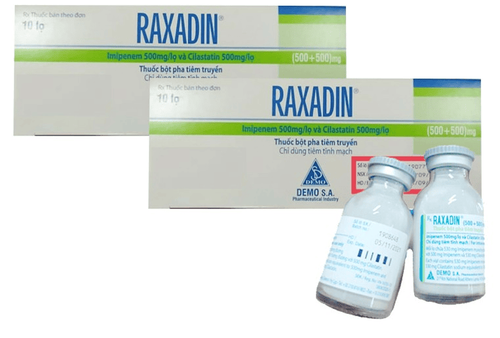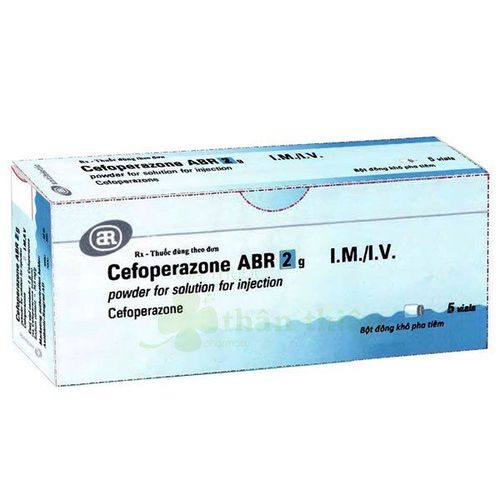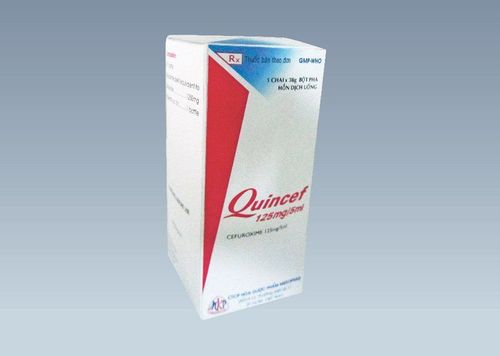This is an automatically translated article.
Cefoxitin is an antibiotic widely used in the treatment of infections caused by susceptible bacteria, which works by stopping the growth of bacteria. What is Cefoxitin used for?1. The effect of the drug Cefoxitin
Before going to learn about the uses of Cefoxitin, let's find the answer to what is Cefoxitin? Cefoxitin is a second-generation cephalosporin antibiotic that inhibits bacterial cell wall synthesis and is used in the treatment of bacterial infections. In addition, Cefoxitin may also be used before and during surgery to help prevent infection. Cefoxitin has a spectrum of activity against many strains of gram-positive and gram-negative bacteria, but is more potent against anaerobes, especially bacteroides fragilis. Cefoxitin is stable to many beta-lactamases including bacteroides spp. However, resistance has emerged in B.fragilis and cross-resistance with other antibiotics may occur.
Cefoxitin is indicated in the treatment of bacterial infections such as:
Lower respiratory tract infections such as lung abscesses, pneumonia,... Urinary tract infections Abdominal infections such as abdominal abscesses, peritonitis Gynecological: endometritis, pelvic inflammatory disease, pelvic cellulitis (however Cefoxitin has no effect on pelvic inflammatory disease caused by chlamydia trachomatis) Bone and joint sepsis Skin and skin structures In addition, a Some other side effects of the drug are not listed on the approved drug label, but in some cases your doctor may prescribe Cefoxitin. Therefore, before using the drug, consult your doctor.
2. How to use Cefoxitin
Cefoxitin is prepared in the form of a powder for injection, so the route of administration can be deep intramuscular injection or slow intravenous injection, intermittent intravenous infusion. In addition, a continuous intravenous line will be used if a high dose of cefoxitin is required. Dosage will be based on the condition and age of the patient.
For mild and uncomplicated infections: 1 gram intravenously slowly over 6-8 hours and the maximum dose is 3-4 grams/day. For moderate or severe infections: 1 gram IV every 4 hours or 2 grams IV every 6-8 hours, maximum dose 6-8 grams/day. For gas gangrene: infections usually require higher doses of antibiotics, 2 grams IV every 4 hours or 3 grams IV every 6 hours, up to a maximum dose of 12 grams/day. Prophylaxis in surgery: Appendicectomy or hysterectomy using a dose of 1-2 grams intravenously. In case of broken organs, use a dose of 1-2 grams intravenously every 6 hours. Renal impairment: With a clearance of 30-50ml/min, use a dose of 1-2 grams every 8-12 hours. With a clearance of 10-30ml/min, use a dose of 1-2 grams every 12-24 hours. With a clearance of 5-9ml/min, use a dose of 500 mg - 1 gram every 24-28 hours. With a clearance of less than 5ml/min, use a dose of 500 mg - 1 gram every 24-48 hours. For children treating infections intravenously 80-160 mg/kg/day and divided every 4-6 hours, higher doses should only be used to treat more severe infections. For surgical prophylaxis, a dose of 30-40mg/kg is given 30-60 minutes before surgery and 30-40mg/kg every 6 hours for 24 hours thereafter. Children with renal impairment adjust the dose as in adults.
3. Undesirable effects when using Cefoxitin drug
Cefoxitin medicine can cause some undesirable and common side effects that can be mentioned as:
Local reactions such as muscle tenderness, muscle pain, muscle cramps when injected intramuscularly or thrombophlebitis when injected vein. Allergic: feeling short of breath, skin rash, erythema, urticaria, exfoliative dermatitis, pruritus, eosinophilia, fever,... Hypersensitivity reactions such as angioedema, anaphylaxis, Toxic epidermal necrolysis rarely occurs. Lower blood pressure Gastrointestinal: nausea, vomiting, diarrhea, pseudomembranous colitis Blood: thrombocytopenia, leukocytosis, anemia including hemolytic anemia, bone marrow failure, hemolysis, prolonged prothrombin time long. In the liver: jaundice, increased transaminase Kidney: increased plasma creatinine, increased blood urea, nephrotoxicity, interstitial nephritis and decreased urine output rarely occur. Myasthenia gravis such as muscle weakness, difficulty chewing, vision changes, difficulty swallowing, difficulty breathing.
4. Some notes when using Cefoxitin
Some notes when using Cefoxitin include:
History of allergy to Cefoxitin hypersensitivity reaction to any other allergy, specifically to cephalosporin antibiotics in particular and beta-lactams in general. Cefoxitin may contain inactive ingredients and could cause an allergic reaction or other serious problems. Report any medications you are taking including prescription and nonprescription drugs, herbs and supplements, foods, dyes or preservatives. Cefoxitin should be used with caution in patients with a history of penicillin allergy, especially hypersensitivity reactions such as angioedema, anaphylaxis, urticaria, or a history of gastrointestinal disease such as colitis. have a history of high-grade convulsive disorders, impaired renal function. For children over 3 months of age, higher than recommended doses are associated with increased incidence of eosinophilia and increased AST. For the elderly, because the drug is excreted by the kidneys, the elderly are prone to decreased kidney function. The drug should not be used for a long time because it can lead to a fungal or bacterial superinfection. Possible symptoms include diarrhea and C. difficile-associated pseudomembranous colitis (cases have been reported with more than 2 months of postoperative treatment). Cefoxitin crosses the placenta, but there are currently no results demonstrating an increased risk of major birth defects or other adverse effects to the fetus or mother after use. Cefoxitin is also one of the antibiotics recommended to be used prophylactically before a cesarean section. If you forget to take a dose of Cefoxitin, inform your healthcare provider right away so that it can be replenished as soon as possible. However, if it is almost time for your next dose, skip the missed dose and inject it as scheduled. Do not use more drug than prescribed treatment. Cefoxitin overdose or ingestion can cause serious symptoms such as nausea, vomiting, abdominal pain, shortness of breath, fainting,...
5. Drug interactions
Some drugs that can interact with Cefoxitin include:
Cefoxitin can reduce the effectiveness of BCG and BCG therapeutic vaccinations, cholera vaccine, typhoid vaccine (need to postpone the use of typhoid vaccine). at least 3 days and cholera vaccine within 14 days of antibiotic administration), lactobacillus, sodium picosulfate and estriol. Cefoxitin may potentiate the effects of sminoglycosides (increase nephrotoxicity), and vitamin K antagonists such as warfarin increase blood clotting. Probenecid may increase serum concentrations of cephalosporins.
6. How to store Cefoxitin
Store Cefoxitin in powder form for injection at room temperature below 30 degrees Celsius, protect from light and avoid humid places. Do not store Cefoxitin in a humid place or in the freezer and keep it away from heat and open flames. Different medicines will have different storage methods, so read the Cefoxitin storage instructions on the package carefully, or ask your pharmacist. Keep Cefoxitin out of the reach of children and family pets. When the medicine has expired or is damaged and cannot be used anymore, dispose of it and dispose of it properly.
To use the medicine safely, use Cefoxitin exactly as directed by your doctor, do not use more than one dose, smaller or longer than prescribed. Use Cefoxitin regularly to get the most benefit from it and you can stop taking it if any new symptoms appear or the condition does not improve after 7 days. Patients absolutely do not abuse the drug for too long for a long time. This does not make the patient's condition better, but also increases the risk of unwanted effects.
Please dial HOTLINE for more information or register for an appointment HERE. Download MyVinmec app to make appointments faster and to manage your bookings easily.













